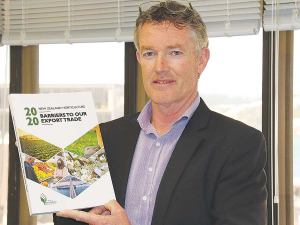US tariffs threaten NZ horticulture exports
"Unwelcome" is how the chief executive of the Horticulture Export Authority (HEA), Simon Hegarty, describes the 15% tariff that the US has imposed on primary exports to that country.
 HEA chief executive Simon Hegarty says they are noticing a rise in other non-tariff measures, which is a big concern for the industry.
HEA chief executive Simon Hegarty says they are noticing a rise in other non-tariff measures, which is a big concern for the industry.
Horticultural exports have increased by 25% over the last two years and tariffs on these exports are down by 29%.
However, New Zealand is by no means out of the woods in terms of protectionist policies – due mainly to the coronavirus pandemic.
That’s the conclusion of a special report on barriers to NZ horticulture exports commissioned by the Horticultural Export Authority (HEA) – the organisation that represents all horticultural exporters. It shows, since the last report of this nature two years ago, horticultural exports have grown to $4.52 million. In the same period, the tariffs that NZ pays on these exports are now $152 million, down from $214 million in 2018. In those two years, kiwifruit exports in value terms increased by 36%, apples by 20%, onions 60%, avocados 15% and potatoes by 11%. However, cherries and buttercup squash exports were down.
The main focus of the report is the issue of trade barriers and non-tariff measures. It singles out India as the country which imposes the highest tariffs on our horticultural exports (43%). However, the worry for NZ, in terms of trade barriers, is our biggest single market for horticultural exports – the European Union. Currently NZ pays at least $61 million (FOB) in tariffs to the EU.
At present, NZ is in the process of negotiating an FTA with the EU and the hope is that some of these barriers will be removed, but no one it seems is holding their breath.
Simon Hegarty, chief executive of HEA, says there has been some relief from tariffs with the advent of the Comprehensive and Progressive Trans Pacific Partnership (CPTPP), which has seen 80% of tariffs to Japan virtually eliminated. Apple exports to Japan are still subject to tariffs, but these are due to be phased out over the next eight years.
FTAs with Canada, Mexico and Peru have also helped and the recent RCEP agreement will also have a positive impact on our exports with an agreement to clear goods faster at borders of participating countries.
“While we are seeing a drop in tariffs we are also noticing a rise in other non-tariff measures, which is a big concern for the industry,” Hegarty says. “Many of these are ‘technical’ barriers which get applied to our products and are unnecessary barriers to our trade.”
He says the outcome of Brexit remains a problem for NZ and warns that there will be some disruption to our exports whether there is a deal or no deal between the UK and EU. Hegarty says there are already problems in the supply chain with shipping delays and Brexit will exacerbate the problem.
Rangitikei Rivers Catchment Collective (RRCC) chairperson Roger Dalrymple says farmers in his region are taking a national lead in water quality awareness and monitoring.
One young couple is proving farm ownership is still within reach for young Kiwis.
Greenlea Premier Meats managing director Anthony (Tony) Egan says receiving the officer of the New Zealand Order of Merit (ONZM) honour has been humbling.
Waikato dairy farmer Neil Bateup, made a companion of the New Zealand Order of Merit (CNZM) in the New Year 2026 Honours list, says he’s grateful for the award.
Another Australian state has given the green light to virtual fencing, opening another market for Kiwi company Halter.
Farmer interest continues to grow as a Massey University research project to determine the benefits or otherwise of the self-shedding Wiltshire sheep is underway. The project is five years in and has two more years to go. It was done mainly in the light of low wool prices and the cost of shearing. Peter Burke recently went along to the annual field day held Massey's Riverside farm in the Wairarapa.

OPINION: The release of the Natural Environment Bill and Planning Bill to replace the Resource Management Act is a red-letter day…
OPINION: Federated Farmers has launched a new campaign, swapping ‘The Twelve Days of Christmas’ for ‘The Twelve Pests of Christmas’ to…